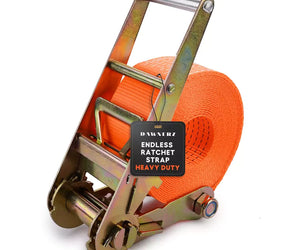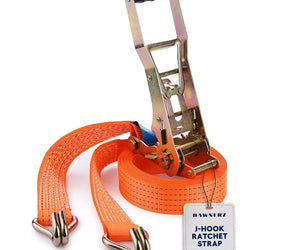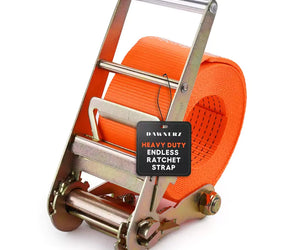Operating Manual
For the purposes of this document, a "synthetic web tie down" refers to a strap assembly made from synthetic webbing—either with or without end hardware—designed to secure cargo during transport. If tie downs are made from alternative materials or built using methods not outlined in this standard, they must be used according to the guidance provided by the manufacturer or a qualified professional.
When using synthetic web tie downs, safety must remain the highest priority. It is the responsibility of the user to choose the appropriate type of strap for the specific cargo, conditions, and securement configuration. Proper knowledge of cargo securement practices is essential, and users must also understand and follow all relevant regulations at the federal, state, provincial, and local levels, as well as applicable industry standards.
Please note: any illustrations included within this publication are intended for general reference only. They are not to be interpreted as specific recommendations for product use, design, or manufacturing techniques.
Identification Requirements for Synthetic Web Tie Downs
Each synthetic web tie down assembly—or individual sub-component, if designed to be detachable—must feature a permanent and legible form of identification applied by the manufacturer. This may be presented in the form of a sewn tag, stencil, or other durable marking method.
The following information is required for compliance:
-
Manufacturer Identification: The name and/or registered trademark of the web tie down manufacturer must be clearly displayed.
-
Working Load Limit (WLL): The rated Working Load Limit must be stated in both pounds (lbs) and kilograms (kg), ensuring the user can determine safe load capacities at a glance.
These identification markings are critical for proper use, regulatory compliance, and safety assurance during cargo securement operations.
Recommended Operating Practices for Web Tie Downs
Proper Selection and Application
Choosing the correct synthetic web tie down is essential to safe and compliant cargo securement. The selected tie down must be appropriate for the load type, environmental conditions, and compatible with the vehicle’s anchor points.
-
Ensure all fittings are the correct size and shape to securely connect to both cargo and vehicle anchor points without risk of slippage or distortion.
-
Verify the Working Load Limit (WLL) clearly marked on the tie down, expressed in both pounds and kilograms.
-
Assess the WLL of anchor points on both the vehicle and cargo. If no rating is visible or documented, consult the vehicle manufacturer or asset owner for guidance.
-
The lowest-rated component—whether the strap or anchor—determines the maximum WLL of the entire securement system.
Determining Quantity of Tie Downs
The number of required tie downs depends on multiple factors:
-
Total weight of the cargo
-
Type and classification of the commodity
-
The aggregate WLL of the securement system
-
Length-to-weight ratio of the load
-
Securement angles, as steeper angles can reduce holding force
It is also the responsibility of both operators and enforcement personnel to be familiar with commodity-specific cargo securement requirements as outlined in:
-
FMCSA’s “Protection Against Shifting and Falling Cargo” (Final Rule effective June 22, 2006 or most recent update)
-
Canada’s National Safety Code (NSC) Standard 10, as amended by the Canadian Council of Motor Transport Administrators (June 2013 or later)
Adhering to these principles ensures load stability, legal compliance, and on-road safety across commercial and industrial transport scenarios.
Use and Care Guidelines for Synthetic Web Tie Downs
To ensure safe performance and long service life, synthetic web tie downs must always be used within the manufacturer’s rated Working Load Limit (WLL).
Angle Consideration
The angle at which tie downs are used affects their efficiency. For example, when straps are applied at a 30° angle from horizontal, their vertical holding force drops by approximately 50%. In such cases, additional tie downs must be added to compensate for reduced effectiveness. This applies specifically to indirect tie-down configurations.

Secure Attachment
Straps must be properly routed and secured to vehicle anchor points based on the type of cargo. Protect all webbing from contact with sharp edges or abrasive surfaces using edge guards or wear sleeves that resist cutting and crushing.
Usage Restrictions
-
Never knot, splice, or alter tie downs to change their length.
-
Do not use synthetic tie downs for towing, lifting, or suspension applications.
-
Winch and ratchet systems should maintain 2–4 wraps of webbing on the mandrel. Insufficient or excessive wraps may compromise strap tension and WLL ratings.
Safety Precautions
-
Always ensure stable footing during operation.
-
Exercise extra caution during cold weather or icy conditions.
-
Do not pull tie downs from under a load.
-
Avoid dragging straps on abrasive surfaces or dropping hardware, which may cause premature wear.
Ongoing Monitoring
Inspect and adjust web tie downs as needed during transit in accordance with federal, state, provincial, and local securement regulations.
Environmental Considerations and Best Practices
Proper storage and environmental awareness can prevent degradation and extend the lifespan of your tie downs.
UV Exposure
Continuous exposure to sunlight and UV rays can degrade synthetic webbing. To minimize damage:
-
Store tie downs in a cool, dry, and shaded location.
-
Ask your supplier about UV-resistant coatings for added protection.
-
Watch for signs of UV damage such as color fading, stiffness, or unexplained surface abrasion.
Chemical Resistance
-
Polyester is resistant to many acids but can degrade under exposure to some.
-
Nylon is more resistant to alkalis but more susceptible to acidic environments.
Before use in chemical settings, evaluate:
-
Type of substance (acid or alkali)
-
Concentration and temperature
-
Duration and exposure conditions
Consult the manufacturer if uncertain about chemical compatibility.
Temperature Tolerance
Web tie downs made from nylon or polyester should not be used:
-
Above 194°F (90°C)
-
Below -40°F (-40°C)
This applies to contact with cargo, vehicles, or anchor points at those temperatures.
Moisture and Contamination
Tie downs exposed to road salt, snow, or mud require frequent inspection and cleaning. Use silicone-based lubricants for moving parts—avoid chlorine-based cleaners, especially on aluminum fittings, to prevent corrosion.
Note: Do not pressure wash or machine wash webbing, as it may cause mechanical damage and degrade strength. Light cleaning with mild soap and water is acceptable, followed by thorough air drying.
If there is any doubt about the integrity of the strap due to UV, chemical, or mechanical exposure—remove it from service or request a proof load test from the manufacturer.



